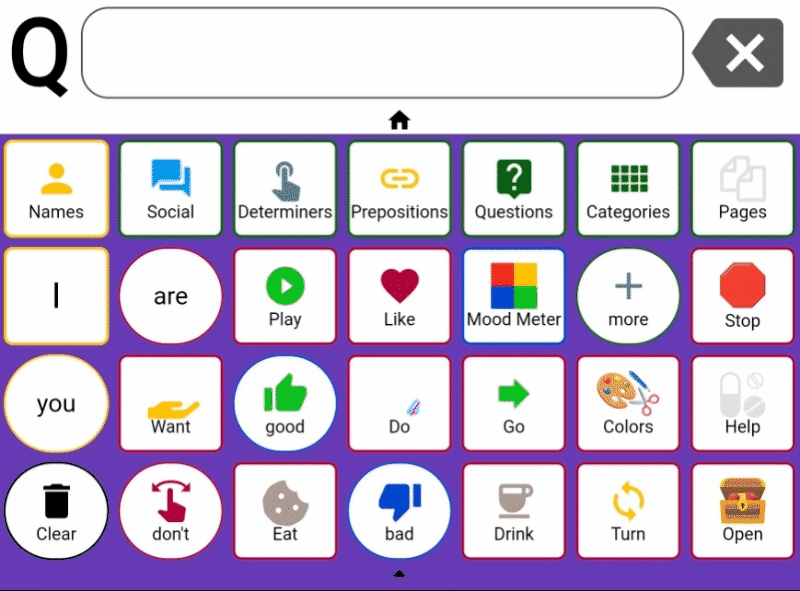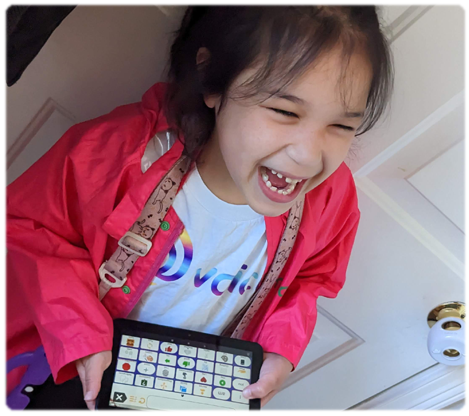A Personal Note from the Founder:
Navigating the world of Augmentative and Alternative Communication (AAC) for my daughter, Quinn, often felt like stepping back in time. The existing solutions struck me as surprisingly outdated, failing to leverage the technological advancements I knew could significantly impact children with cognitive delays like Quinn. I saw firsthand how these archaic approaches weren't truly engaging her or empowering her communication partners effectively. It was this frustration, this sense that Quinn deserved so much more than what was currently available, that ignited a personal mission. As a mobile app developer (15+years) and, more importantly, as Quinn's mom (6+years), I knew I could build something better, something that truly understood her unique needs. QVoice isn't just an incremental improvement; it's a deliberate leap forward, incorporating features I knew would be game-changers for Quinn – like the dynamic visual support of GIFs, the essential inclusivity of web-based accessibility for her entire team, and the long-overdue focus on tools that empower everyone involved in her communication journey. This app is born from a conviction that our kids deserve cutting-edge solutions, not yesterday's technology.
Our Core Mission
Our mission is to provide a quick, effective, and engaging voice for individuals with cognitive challenges. Born from a parent's journey, QVoice is thoughtfully designed to reduce the user's cognitive load while empowering the entire communication team—parents, SLPs, and educators—with smart, supportive tools.
Our Guiding Principles
This mission is guided by three key principles:
Prioritize the User's Success: We focus on making communication as intuitive and successful as possible. Every feature, from the layout to the AI engine, is designed to lower the barrier to expression and build the user's confidence.
Empower the Communication Partner: We believe that successful AAC implementation is a team effort. We are committed to creating powerful, easy-to-use tools that help parents and providers teach, model, and generalize language in a way that is both effective and efficient.
Build with Purpose: Every feature in QVoice is connected to a real-world need. We are dedicated to using technology thoughtfully to solve genuine problems, ensuring the app remains practical, focused, and free of unnecessary complexity.
How is QVoice different?
 | Our design philosophy is built on a powerful principle: prioritize by cognition. This tree shows our method. We start with the root word—the foundation of meaning—because a clear and simple start is crucial for users with cognitive delays. Complex forms, like the leaves, aren't eliminated; they are thoughtfully layered. We are focused on root form of words; not conjugations, tenses, and pluralizations [yet ?]. Keeping the core user—someone like Quinn who needs quick and effective communication—at the center of every design decision is the most important thing. We are designing for clarity and success in the moment, not for linguistic perfection.³ When a user is ready for more complexity, those advanced forms are just a step away. If not, their screen remains uncluttered. This 'root-first' approach allows us to optimize screen real estate for what matters most: access to more word choices. For proficient users who want more control, we've got big plans for you. Stay tuned... |
 | We use animations such as GIFs, folder transitions, or hinting.¹
|
 | You should not have to be tech-savvy in order to program an AAC system.
|
 | With QVoice's AI, users only need to select two or more words to generate a complete sentence. This significantly reduces the initial motor learning burden while allowing for grammatically correct communication. Speaking in full sentences can lead to better understanding and presentation. We're having fun exploring the potential of this feature! Read more here. |
 | We have real-time synchronization across web, mobile, iOS, and Android platforms
|
  | We take full advantage of system resources to keep our costs low.
|
 | Every feature is tied to real-life examples (we can name who each feature/widget was built for)
|
 | We believe in equal access, despite cognitive delays.
|
 | We have automatic data collection to provide accurate usage insights.
|
 | We learned from attending so many conferences how important personalizations are!!! This helps increase ownership. So we built QVoice to be everyone's voice (T's voice, M's voice, etc). We want the device to show off each QVoicer's style and personality. As soon as you see the device on the table, you'll know who it belongs to. |
 | Smart Buttons (current in BETA) automatically change in the grid to show the correct grammatical form based on the words already in your sentence bar. This provides clear visual feedback and helps model correct language. |
Read more about Grid Layouts and why are they important to understand the distinct architectural approach we took in building QVoice, setting it apart from other AAC solutions.
QVoice is a continuous work in progress. As we learn more, we change. When we know better, we do better. We have so many ideas and initiatives. Please consider signing up for QVoice. Join our community and help us improve QVoice for the masses.
References for Further Reading:
- Liang, Xiaoning (2024) Back to the Basics: What icons do our brains prefer?
- Laubscher, Emily (2024) You Just Want to Be Able to Communicate With Your Child”: Parents' Perspectives on Communication and AAC Use for Beginning Communicators on the Autism Spectrum Authors
Was this article helpful?
That’s Great!
Thank you for your feedback
Sorry! We couldn't be helpful
Thank you for your feedback
Feedback sent
We appreciate your effort and will try to fix the article